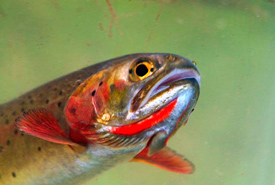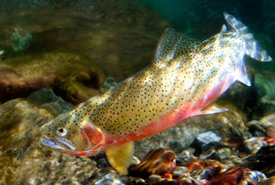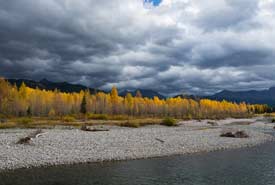Something's Fishy: The freshwater slasher

Westslope cutthroat trout (Photo by Wikimedia Commons)
When you think about Halloween, spooky species such as spiders with venomous fangs and blood-sucking bats usually come to mind. Of course, Hollywood is often to blame for these misrepresentations of species, with accounts of bats turning into vampires and giant, slithering two-headed snakes.
But what if I told you there was a species swimming in Canadian waters with a name, appearance and conservation status that would leave Jason Voorhees himself trembling behind his hockey mask?
Westslope cutthroat trout is a species of salmonid and is native to western North America. The westslope is one of two of cutthroat trout subspecies swimming in Canadian waters. It is found primarily in freshwater lakes and rivers in British Columbia and Alberta. Due to its need for cold, highly oxygenated water bodies, this species is a great indicator of ecosystem health.
Similar to Atlantic salmon, the westslope cutthroat trout will experience different stages throughout its life. These stages are almost entirely based on the location of the fish. Stream residents are the smallest in size and are usually restricted by stream-size, fluvial fish (medium-sized). The largest form, adfluvial, inhabits spawning tributaries and rivers.

Adult westslope cutthroat trout, Alberta population (Photo by Fisheries and Oceans Canada)
This species has traits similar to many members of the salmonid family — adipose (fat-storing) fin, large mouth, dark spots on its body. But one special feature has earned this fish its tough-as-nails name. Beneath the lower jaw, westslope cutthroat trout have two bright red-orange slashes that extend from the middle of its mouth past its eye. It is not certain why these slashes exist. Although they are near the gills, they are not used for breathing.
These slashes may look bigger and fiercer while the fish is spawning, as they will adopt a bright red colouration on the fish's belly. This can be seen in both Alberta and BC populations, although BC populations are more heavily spotted on the back half of the body compared to populations in Alberta.
While this fish might look scary, there is one thing more frightening than its appearance: its conservation status.
Both AB and BC populations of westslope cutthroat trout are decreasing due to changes in its environment. Factors such as forest harvest, mining, aquaculture and invasive species are negatively impacting the survival of these species in Canadian waters. BC populations are considered a species of special concern according to the Committee on the Status of Endangered Wildlife in Canada, while AB populations are listed as threatened.

The Wigwam River on Mt. Broadwood, in the Elk Valley Heritage Conservation Area. (Photo by Lyle Grisdale)
The good news is, conservation efforts are underway to one day put this nightmare to bed for good. The Nature Conservancy of Canada (NCC) is contributing to the protection of this species by conserving habitat for BC populations of westslope cutthroat trout in several areas, including Darkwoods, Cherry Meadows and the Elk Valley Heritage Conservation Area. By ensuring the lakes, rivers and watershed in these areas are healthy, populations of all fish can successfully reproduce and flourish.
This Halloween, when you think of all the spooky species Canada has to offer, don’t forget the little fish with the slashed throat swimming in our waters.
Something’s Fishy is a monthly series written by NCC’s Editorial Coordinator, Raechel Bonomo, highlighting a species or group of fishes that inhabitant Canadian waters.


